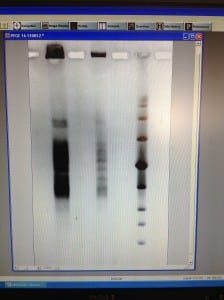Hey All,
When we checked the growth of the 10 different strain samples of propionibacterium acnes this morning we were happy with most of them, expect a few which were still abit clear. We decided to proceed anyway with plug making, adding chloramphenicol to them for a hour, then centrifuging down 3ml of all samples.
We then centifuged the others further down until all pellets appeared the same size and roughly the same size as the previous most successful plug making. While doing this we melted agarose in a waterbath slowly at 50C.
Once all pellets were appropriate sizes, we added cell suspension buffer, eluted the pellets and added agarose. We kept the agarose, cell suspension buffer and cells at 50C, and pipetted each sample into a mold. Producing 1 plug per sample.
Once solidified, we pushed each plug into a separate universal, added lysozyme, buffer and mutanolysin. This is now incubating at 37C until half 7/half 8pm. After which Mike will remove lysozyme, buffer and mutanolysin and add proteinase K and buffer, incubating it at 50C until tomorrow morning.
Unfortunatly we ran out of lysozyme and proteinase K buffers, so Mike had us make up our own from 1M tris HCL pH8 buffer, sodium dodeyl sulphate (SDS), 0.5M EDTA pH8 and pure water.
Tomorrow we will be washing the plugs and incubating them in SpeI. See you all tomorrow!
